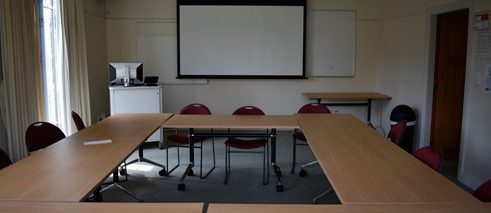Learning Curve
Wellington
Learning how to teach – and teaching how to learn
Only a couple of weeks after I started my doctoral studies at Victoria University, my supervisor asked me if I would like to be a teaching assistant for the course Popular Media Culture. Still in the early stages of “settling in” – trying to find my way around a new university and a new city – teaching undergraduate students sounded a bit scary but pretty exciting at the same time.
I accepted the challenge and started to get familiar with the course outline, which included different concepts and theories relating to the social function and value of popular media culture.
 Classroom | © Katie Rochow
My very first tutorial was about introducing the students to semiotics – the science of how signs and symbols communicate. Not a very easy start to the trimester. I had to find ways to break down concepts such as denotation and connotation, explain the difference between sign, signifier and signified, and the meaning of iconic, indexical and symbolic signs. How would my English hold up to this? Would the students understand what I am talking about? Would I be able to express myself clearly? I was rather nervous about my first tutorial and unsure if I would like teaching or not.
Classroom | © Katie Rochow
My very first tutorial was about introducing the students to semiotics – the science of how signs and symbols communicate. Not a very easy start to the trimester. I had to find ways to break down concepts such as denotation and connotation, explain the difference between sign, signifier and signified, and the meaning of iconic, indexical and symbolic signs. How would my English hold up to this? Would the students understand what I am talking about? Would I be able to express myself clearly? I was rather nervous about my first tutorial and unsure if I would like teaching or not.
Soon I realized that with the help of slides, images, Youtube clips and videos the students and I could have engaging discussions about any of those complex concepts, ideas and theories that we learned about in the lectures and in the readings. In fact, I was quite excited when I could draw on my experiences with the European media landscape during the tutorials and introduce the students to German or Scandinavian culture and music such as Kraftwerk, Alle Farben and Trentemøller.
 Grading Assignments | © Katie Rochow
Perhaps a less exciting part of being a teacher is marking assignments. At the end of the term, my students had to submit their final research essays. Grading their papers meant reading about semiotics, postmodernism, new media and popular music over and over and over again, which was quite draining (and this kind of work is definitely underpaid). Nevertheless there are always students that come up with fascinating and impressive essays, which feels rewarding, inspiring and satisfying.
Grading Assignments | © Katie Rochow
Perhaps a less exciting part of being a teacher is marking assignments. At the end of the term, my students had to submit their final research essays. Grading their papers meant reading about semiotics, postmodernism, new media and popular music over and over and over again, which was quite draining (and this kind of work is definitely underpaid). Nevertheless there are always students that come up with fascinating and impressive essays, which feels rewarding, inspiring and satisfying.
Even though teaching Media Studies at university level seemed pretty scary at first, it was one of my favourite activities as a doctoral student, and it has become my full-time employment in the past year. Helping the students to understand, think critically, write and talk about complex ideas and concepts about media, music and culture is rewarding, inspiring and a lot of fun!
 Campus | © Katie Rochow
Campus | © Katie Rochow
